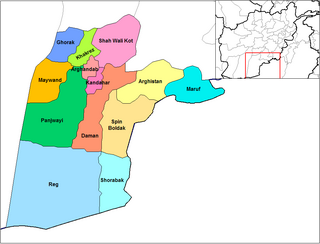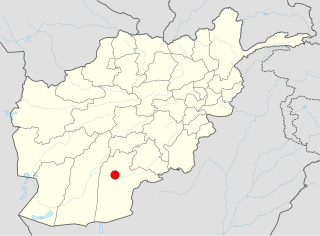
Kandahār is one of the thirty-four provinces of Afghanistan, located in the southern part of the country, sharing a border with Pakistan, to the south. It is surrounded by Helmand in the west, Uruzgan in the north and Zabul Province in the east. Its capital is the city of Kandahar, Afghanistan's second largest city, which is located on the Arghandab River. The greater region surrounding the province is called Loy Kandahar. The Emir of Afghanistan sends orders to Kabul from Kandahar making it the de facto capital of Afghanistan, although the main government body operates in Kabul. All meetings with the Emir take place in Kandahar, meetings excluding the Emir are in Kabul.

Panjwayi is a district in Kandahar Province, Afghanistan. It is located about 35 kilometres (22 mi) west of Kandahar. The district borders Helmand Province to the southwest, Maywand District to the west, Zhari District to the north, Arghandab, Kandahar and Daman districts to the east and Reg District to the south. Panjwayi was reduced in size in 2004 when Zhari District was created out of the northern part of it, on the northern side of the Arghandab River, which now forms the northern boundary.

Arghandab is a district in the central part of Kandahar Province, Afghanistan. It borders Panjwai and Khakrez districts to the west, Shah Wali Kot District to the north and east and Kandahar District to the east and south.
Zhari is a district in Kandahar Province, Afghanistan. Alternative spellings include Zheley, Zharey, Zharay, Zheri, or Zheray. The district was created in 2004 from land that was formerly part of Maywand and Panjwai districts. The population is estimated at 80,700 (2010).
Damadola is a village in the Bajaur District of the Khyber Pakhtunkhwa in Pakistan, about 7 km (4.3 mi) from the Afghanistan border, it is located at 34° 48' 20N 71° 28' 0E at an altitude of 1082 metres. The village gained international attention in early 2006 after the U.S. launched an airstrike on Damadola killing at least 18 people. It was captured by Frontier Corps from Taliban by February 6, 2010.
During the War in Afghanistan, according to the Costs of War Project the war killed 176,000 people in Afghanistan: 46,319 civilians, 69,095 military and police and at least 52,893 opposition fighters. However, the death toll is possibly higher due to unaccounted deaths by "disease, loss of access to food, water, infrastructure, and/or other indirect consequences of the war." According to the Uppsala Conflict Data Program, the conflict killed 212,191 people. The Cost of War project estimated in 2015 that the number who have died through indirect causes related to the war may be as high as 360,000 additional people based on a ratio of indirect to direct deaths in contemporary conflicts.
Operation Mountain Thrust was a joint NATO and Afghan-led military operation in the War in Afghanistan. It involved more than 3,300 British troops, 2,300 U.S. troops, 2,200 Canadian troops, along with approximately 3,500 Afghan soldiers, supported by extensive air power. Its primary objective was to quell the ongoing Taliban insurgency in the south of the country.

Operation Medusa was a Canadian-led offensive during the second Battle of Panjwaii of the War in Afghanistan. The operation was fought primarily by the 1st Battalion, The Royal Canadian Regiment Battle Group and other elements of the International Security Assistance Force, including A Co, 2-4 Infantry BN, 4th BDE, 10th Mtn Division, supported by the Afghan National Army and a team from the United States Army's 1st Battalion, 3rd Special Forces Group (Airborne) augmented by C Company, 2nd Battalion, 87th Infantry Regiment of the 10th Mountain Division. Its goal was to establish government control over an area of Kandahar Province centered in the district of Panjwayi some 30 kilometres (19 mi) west of Kandahar city. A tactical victory, it resulted in the deaths of 12 Canadian soldiers; five during the major combat operations, five in bombings, and two in a mortar/RPG attack during the reconstruction phase of the operation. Fourteen British military personnel were also killed when their plane crashed. Despite suffering a brutal battlefield defeat, the Taliban retained their presence in Kandahar province and did not lose their will to fight, leading to the subsequent Operation Falcon Summit. Nonetheless, Operation Medusa was at the time the most significant land battle ever undertaken by NATO.

Operation Mountain Fury was a NATO-led operation begun on September 16, 2006 as a follow-up operation to Operation Medusa, to clear Taliban insurgents from the eastern provinces of Afghanistan. Another focus of the operation was to enable reconstruction projects such as schools, health-care facilities, and courthouses to take place in the targeted provinces.
Events from the year 2007 in Afghanistan.

The Battle of Arghandab, codenamed Operation IBRAT by the insurgents, began on June 18, 2008, when NATO-led forces attacked Taliban militants in response to Taliban attacks in Arghandab District and Kandahar in Afghanistan. The battle in Arghandab marked the second time in less than a year that the Taliban tried to take control of the area.
The Azizabad airstrike was carried out by the United States Air Force on Friday 22 August 2008 in the village of Azizabad in Shindand district, Herat Province, Afghanistan. The airstrike killed 92 civilians, mostly children, and a number of structures in the village including homes were damaged or destroyed, although there remains some dispute about the accuracy of these figures. A Taliban commander was the intended target of the airstrike.
Events from the year 2010 in Afghanistan.
Operation Dragon Strike was a NATO counter-insurgent mission in Kandahar province, Afghanistan, against Taliban forces, which started on September 15, 2010.
Events from the year 2011 in Afghanistan.
Tarok Kolache was a small settlement in Kandahar province, Afghanistan.

The Kandahar massacre, also called the Panjwai massacre, was a mass murder that occurred in the early hours of 11 March 2012, when United States Army Staff Sergeant Robert Bales murdered 16 Afghan civilians and wounded six others in the Panjwayi District of Kandahar Province, Afghanistan. Nine of his victims were children, and 11 of the dead were from the same family. Some of the corpses were partially burned. Bales was taken into custody later that morning when he told authorities, "I did it".
Lower Babur is a village in the Arghandab District of Kandahar Province in southern Afghanistan that was destroyed by American military forces in October and November 2010.







